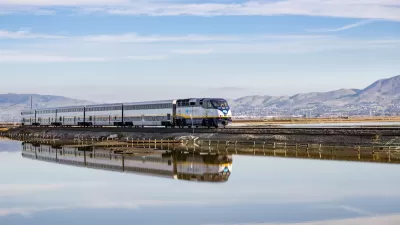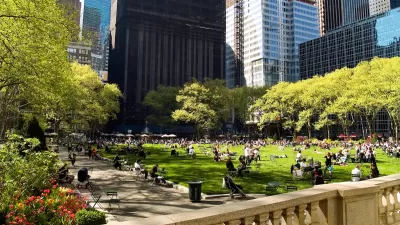About two years ago, after teaching a course at NYU's Interactive Telecommunications Program on "Digitally Mediated Urban Space", I wrote an article for the architectural design journal Praxis that sought to do do two things: 1) make sense of the wide array of digital technologies that are being deployed in urban space, and 2) present a couple of places that I thought exemplified good and bad "design" of digital public spaces. Recently, my research on context-aware computing - computing based on sensors and artificial intelligence - has led me to revisit this piece. Around the same time, I got a call from Lucas Graves, a friend who writes for Wired, and was doing a piece on technologies that are "perpetually around the corner". Lucas was mainly interested in things like videophones, but it coincided with a turn in my research to the applications side of context-awareness: smart cities, smart places, smart homes, and smart objects. As an urban planner, I immediately gravitated to thinking about smart cities and smart places, but wondered in the back of my mind - is this something that is really happening, or just another one of those technologies that are perpetually around the corner?
About two years ago, after teaching a course at NYU's Interactive Telecommunications Program on "Digitally Mediated Urban Space", I wrote an article for the architectural design journal Praxis that sought to do do two things: 1) make sense of the wide array of digital technologies that are being deployed in urban space, and 2) present a couple of places that I thought exemplified good and bad "design" of digital public spaces.
Recently, my research on context-aware computing - computing based on sensors and artificial intelligence - has led me to revisit this piece. Around the same time, I got a call from Lucas Graves, a friend who writes for Wired, and was doing a piece on technologies that are "perpetually around the corner". Lucas was mainly interested in things like videophones, but it coincided with a turn in my research to the applications side of context-awareness: smart cities, smart places, smart homes, and smart objects. As an urban planner, I immediately gravitated to thinking about smart cities and smart places, but wondered in the back of my mind - is this something that is really happening, or just another one of those technologies that are perpetually around the corner?
On further reflection, I think it is a little of both, and it really depends on what you think when you say "smart city". I've never rally been too comfortable with the idea of a "smart city" because it implies centralized intelligence, a sort of optimized utopian machine for living in. If the debacle of responding to the destruction in New Orleans is any lesson, its that this vision of centralized urban intelligence is a far cry from today's reality (whether it is desiteable or not). We can say cities are already smart because in the typical American city today, almost nothing or nobody can live through a single day without triggering multiple actions through telecommunications networks. Driving to the supermarket and buying milk triggers thousands of interactions between you, your bank, supply chains, roadway sensors, and surveillance networks.
On the other hand, there is a lot of evidence that smart cities and smart places are always going to be just around the corner for two reasons.
The first reason is that no one really in control of urban space. It's a contentious thing that is negotiated. One of the major points I tried to make in the Praxis article was that the social, political and physical complexity of the built environment was going to be a powerful moderating and shaping force on digital technology, which to date has largely been confined to the office and the home.
The second reason is that the built environment is generally on a 50 to 100-year product cycle. Even when there is consensus about change, there is nothing that changes more slowly. One of the exercises from that class was to send students out in New York to catalog all of the fixed and mobile digital technologies in use in public spaces. Sure, some of the more central places in Manhattan like Times Square had a lot of things going on - multiple wireless grids, large outdoor displays, vehicles using GPS, etc - I remember being surprised how difficult a time they had. Cell phones were used everywhere, though certain places were especially dense with users - just outside subway stations, etc. Here and there a laptop or a PDA. Displays seeping out from inside buildings into windows and facades, but oh so slowly. The main reason is that things get built very slowly, and digital technologies only get introduced when those rebuilding activities take place.
I experienced this reality first-hand a few years ago in New York City. In the spring of 2002, I was working with some friends on a project to setup free Wi-Fi in Midtown Manhattan's Bryant Park. Installing the necessary hardware was actually pretty easy - we just clamped a few antennas on top of the park's maintenance shed, and ran some insulated conduit down through the roof to a T1 endpoint. However, we knew that people using laptops in the park weren't just going to want wireless Internet, but they were also going to need electrical power, so we started planning sites around the park for public power outlets.
Unfortunately, I was about to get a big lesson in the politics of public space. For what had happened was that we had missed the park's 5-year capital spending planning cycle. The trenching, moving of big granite sidewalk blocks, and conduit installation needed to create new public power stations needed to be funded, and we had missed the boat - major modifications of the "physical plant" of the park were planned very far in advance. There were two other complicating factors. First - any number of organizations from the city's Landmarks Preservation Commission to the Municipal Art Society wield effective veto power over new fixtures in the park. Assuming we could get the power lines installed, it might take 6 months of hearings to figure out how to make an outlet that would fit into the park's 19th-century design. Second, the New York Public Library had a major vault underneath the park, where many valuable texts were archived. They were nervous about any construction planned for the park above, especially those that involved water or electricity (risks of flood and fire).
Why should we care? Because trying to pursue policies that seek to create "smart places" and "smart cities" is inevitably and fundamentally going to cause conflict. The product cycle of the city is 50-100 years, in infotech, its 12-18 months.

Maui's Vacation Rental Debate Turns Ugly
Verbal attacks, misinformation campaigns and fistfights plague a high-stakes debate to convert thousands of vacation rentals into long-term housing.

Planetizen Federal Action Tracker
A weekly monitor of how Trump’s orders and actions are impacting planners and planning in America.

In Urban Planning, AI Prompting Could be the New Design Thinking
Creativity has long been key to great urban design. What if we see AI as our new creative partner?

King County Supportive Housing Program Offers Hope for Unhoused Residents
The county is taking a ‘Housing First’ approach that prioritizes getting people into housing, then offering wraparound supportive services.

Researchers Use AI to Get Clearer Picture of US Housing
Analysts are using artificial intelligence to supercharge their research by allowing them to comb through data faster. Though these AI tools can be error prone, they save time and housing researchers are optimistic about the future.

Making Shared Micromobility More Inclusive
Cities and shared mobility system operators can do more to include people with disabilities in planning and operations, per a new report.
Urban Design for Planners 1: Software Tools
This six-course series explores essential urban design concepts using open source software and equips planners with the tools they need to participate fully in the urban design process.
Planning for Universal Design
Learn the tools for implementing Universal Design in planning regulations.
planning NEXT
Appalachian Highlands Housing Partners
Mpact (founded as Rail~Volution)
City of Camden Redevelopment Agency
City of Astoria
City of Portland
City of Laramie






























